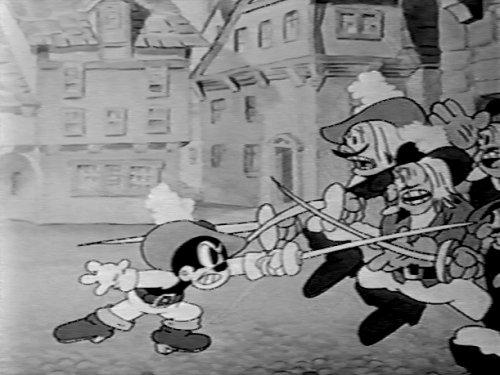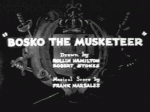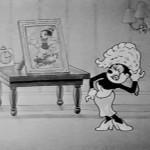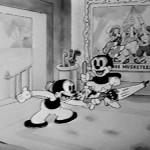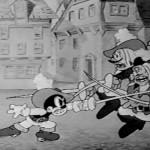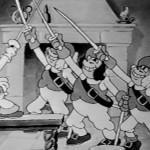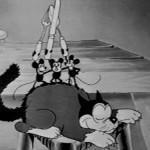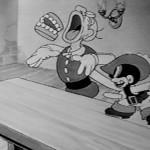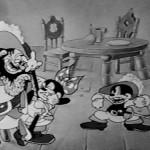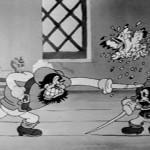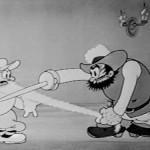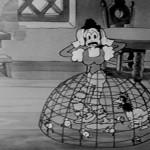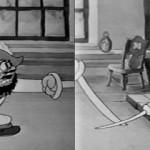Credits: Supervision by – Hugh Harman Summary: Bosko imagines himself as musketeer who has to save Honey from the clutches of an evil villain. Description: Bosko and Bruno are strolling through the woods on their way to Honey’s house. As Bosko sings “She Loves Me, She Loves Me Not”, Honey is doing some house-cleaning in anticipation of his arrival. She dusts her table, her goldfish, and her autographed picture of Bosko. As she looks at the photo, she morphs into Mae West and declares “You can be had!”. Bosko finally arrives as Honey is dusting a large portrait of The Three Musketeers. “Ain’t they grand, Bosko?” she asks, pointing at the portrait. Bosko replies with “Shucks, that’s nothing! Watch this!”, then pulls out an umbrella and mimics a sword fight. As Honey sings about Bosko being a “soldier brave and bold”, the scene dissolves into an actual fight between Bosko (dressed in genuine Musketeer garb) and a quartet of genuine villains. Bosko defeats them by opening up the valve in an enormous beer barrel and washing his enemies away (while his his glove and sword wait in mid-air for his hand to return). Bosko strolls into the local pub and shouts “Hi-dee-hi! Ho-dee-ho! Ho-dee-hey!”. A title card appears on screen which reads “The Three Musketeers”, who appear and suddenly break out into song. Bosko introduces them as “Athos, Amos and Andy!”. As they sing “All for One and One for All”, Bosko curls his sword around a table leg — forming a corkscrew — then pops open a bottle of “New Deal” liquor. A trio of silverware-wielding mice perched atop a cat join in the song briefly. Bosko pours the drink into Athos’ mouth, Amos swallows it, and Andy burps. The Musketeer’s song now concluded, their audience cheers in delight. One man toots a chicken like a car horn, and another man shouts “Hip-Hip!”, prompting a mouse to pop out of his drink and yell “Hooray!”. But one surly-looking man jeers the performance, and it can be assumed with reasonable certainty that he’ll be the villain of the story. As if to prove to us how tough he is, he swallows a cooked chicken whole, pulling out nothing but bones, then uses another man’s teeth as a bottle opener. Honey is the next performer, greeting her audience by shouting “Here I am you lucky people!” before starting her tap routine. Bosko watches intently, then turns to the old man sitting next to him and comments “Boy, ain’t she keen!”. Bosko then slaps the man on the back so hard that his false teeth fly out of his mouth! The villain has taken an interest in Honey as well, so he grabs her off the floor and places her on his lap. She shouts “Bosko! Help!”, and Bosko leaps to her rescue. Honey frees herself while Bosko and the villain prepare for battle. They cross swords, the swords shake hands, and the battle begins. Bosko avoids the villain’s attacks by ducking and leaping, but the villain is able to jab the plume in Bosko’s hat — which turns out to be a chicken that flies away in terror! Bosko manages to cut off his opponent’s blade, so the villain calls for his caddie, who arrives with a golf bag full of swords! The villain sharpens his sword on the caddie’s beard, while Bosko puts his bent sword through a pencil sharpener. The villain grabs a nearby clothes hanger and uses it as a bow to shoot his sword at Bosko. Bosko ducks, but the sword rips the skirt off a nearby woman, revealing a hen and baby chicks underneath! The fight resumes, and Bosko is backed into a fireplace. Bosko hurls hot coals into the villain’s pants, who shouts in pain and runs out the door. Honey runs up to her hero and applauds, but the scene dissolves back to Honey’s house. “Oh Bosko, I don’t believe that!” shouts Honey, but Bosko replies with “Was you dere, Charlie?”. Notes:
Memorable Scenes: Video Availability: None
|
